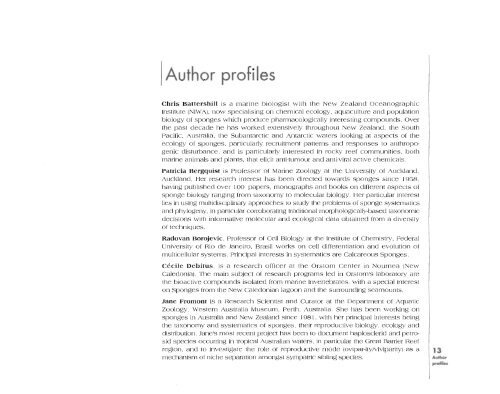Sponges of the New Caledonian lagoon - IRD
Sponges of the New Caledonian lagoon - IRD
Sponges of the New Caledonian lagoon - IRD
Create successful ePaper yourself
Turn your PDF publications into a flip-book with our unique Google optimized e-Paper software.
Author pr<strong>of</strong>iles<br />
Chris Battershill is a marine biologist with <strong>the</strong> <strong>New</strong> Zealand Oceanographic<br />
Institute (NIWA), now specialising on chemical ecology, aquaculture and population<br />
biology <strong>of</strong> sponges which produce pharmacologically interesting compounds, Over<br />
<strong>the</strong> past decade he has worked extensively throughout <strong>New</strong> zealand, <strong>the</strong> South<br />
Pacific, Australia, <strong>the</strong> Subantarctic and Antarctic waters looking at aspects <strong>of</strong> <strong>the</strong><br />
ecology <strong>of</strong> sponges, particularly recruitment patterns and responses to anthropogenic<br />
disturbance, and is particularly interested in rocky reef communities, both<br />
marine animals and plants, that elicit anti-tumour and anti-viral active chemicals.<br />
Patricia Bergquist is Pr<strong>of</strong>essor <strong>of</strong> Marine zoology at <strong>the</strong> University <strong>of</strong> Auckland,<br />
Auckland, Her research interest has been directed towards sponges since 1958,<br />
having published over 100 papers, monographs and books on different aspects <strong>of</strong><br />
sponge biology ranging from taxonomy to molecular biology, Her particular interest<br />
lies in using multidisciplinary approaches to study <strong>the</strong> problems <strong>of</strong> sponge systematics<br />
and phylogeny, in particular corroborating traditional morphologically-based taxonomic<br />
decisions with informative molecular and ecological data obtained from a diversity<br />
<strong>of</strong> techniques,<br />
Radovan Borojevic, Pr<strong>of</strong>essor <strong>of</strong> Cell Biology at <strong>the</strong> Institute <strong>of</strong> Chemistry, Federal<br />
university <strong>of</strong> Rio de Janeiro, Brasil works on cell differentiation and evolution <strong>of</strong><br />
multicellular systems, Principal interests in systematics are Calcareous <strong>Sponges</strong>.<br />
Cecile Debitus, is a research <strong>of</strong>ficer at <strong>the</strong> Orstom Center in Noumea (<strong>New</strong><br />
Caledonia). The main subject <strong>of</strong> research programs led in Orstom's laboratory are<br />
<strong>the</strong> bioactive compounds isolated from marine Invertebrates, with a special interest<br />
on <strong>Sponges</strong> from <strong>the</strong> <strong>New</strong> <strong>Caledonian</strong> <strong>lagoon</strong> and <strong>the</strong> surrounding seamounts.<br />
Jane Fromont is a Research Scientist and Curator at <strong>the</strong> Department <strong>of</strong> Aquatic<br />
zoology, western Australia Museum, Perth, Australia. She has been working on<br />
sponges in Australia and <strong>New</strong> Zealand since 1981, with her principal interests being<br />
<strong>the</strong> taxonomy and systematics <strong>of</strong> sponges, <strong>the</strong>ir reproductive biology, ecology and<br />
distribution. Jane's most recent project has been to document haplosclerid and petrosid<br />
species occurring in tropical Australian waters, in particular <strong>the</strong> Great Barrier Reef<br />
region, and to investigate <strong>the</strong> role <strong>of</strong> reproductive mode (ovipar-itylviviparity) as a<br />
mechanism <strong>of</strong> niche separation amongst sympatric sibling species.<br />
13<br />
Author<br />
pr<strong>of</strong>iles

















